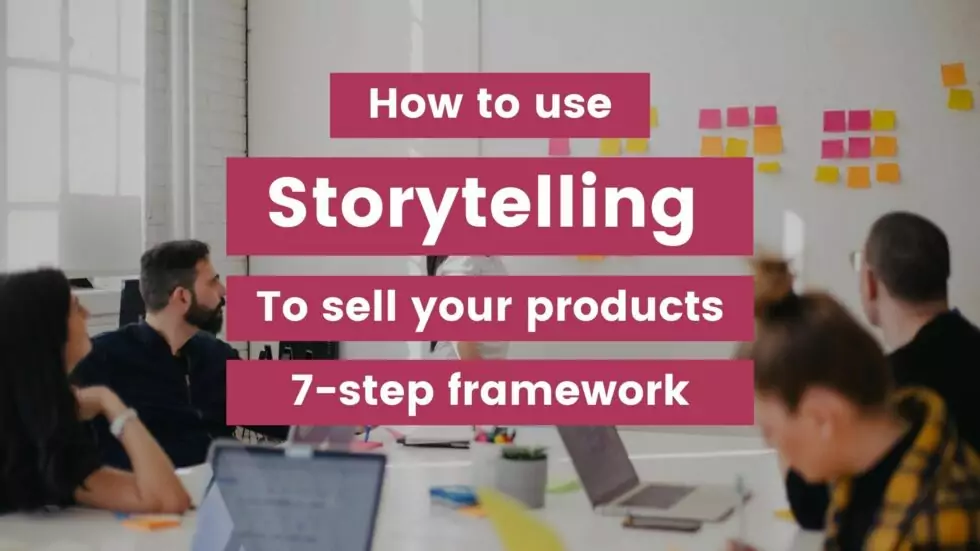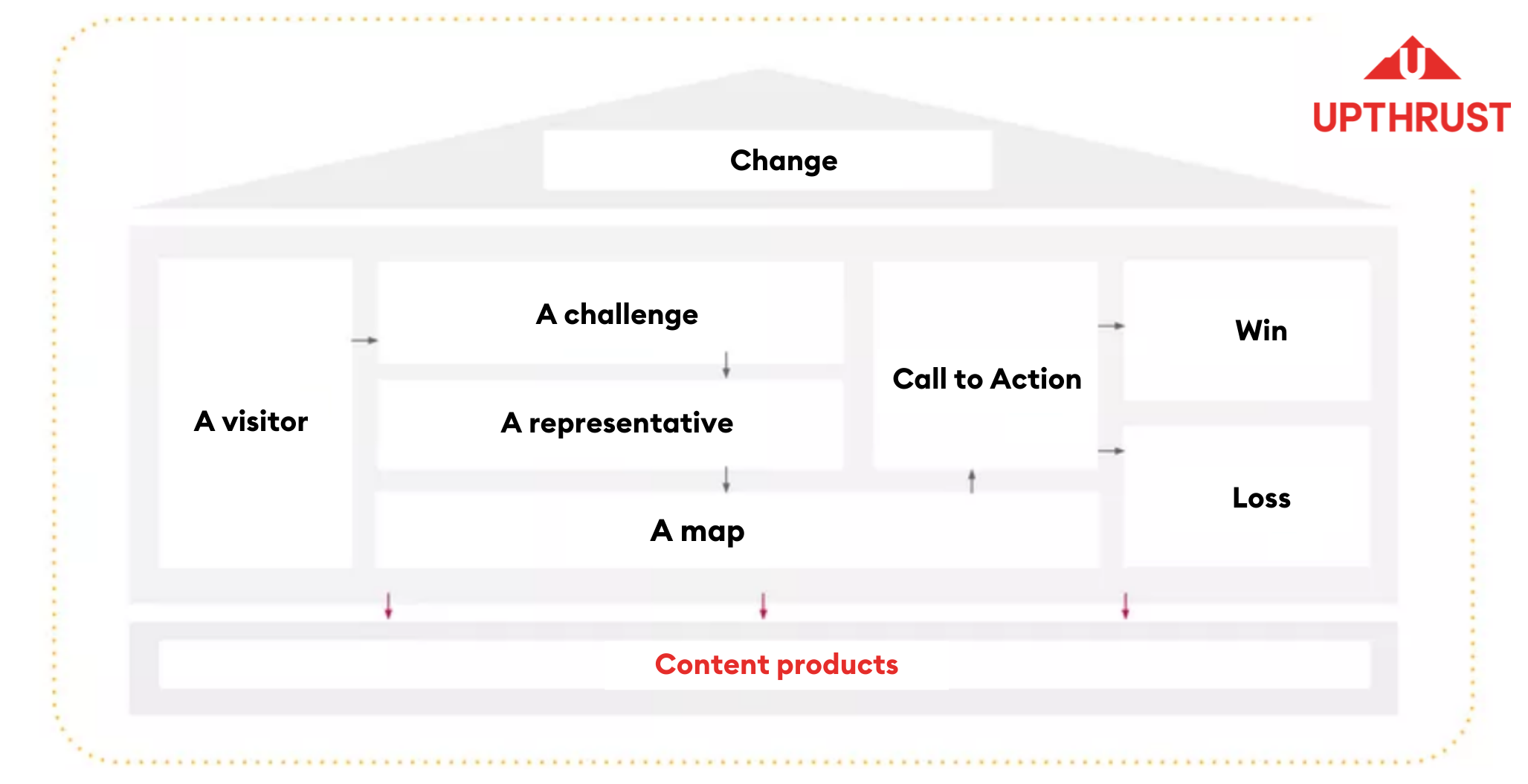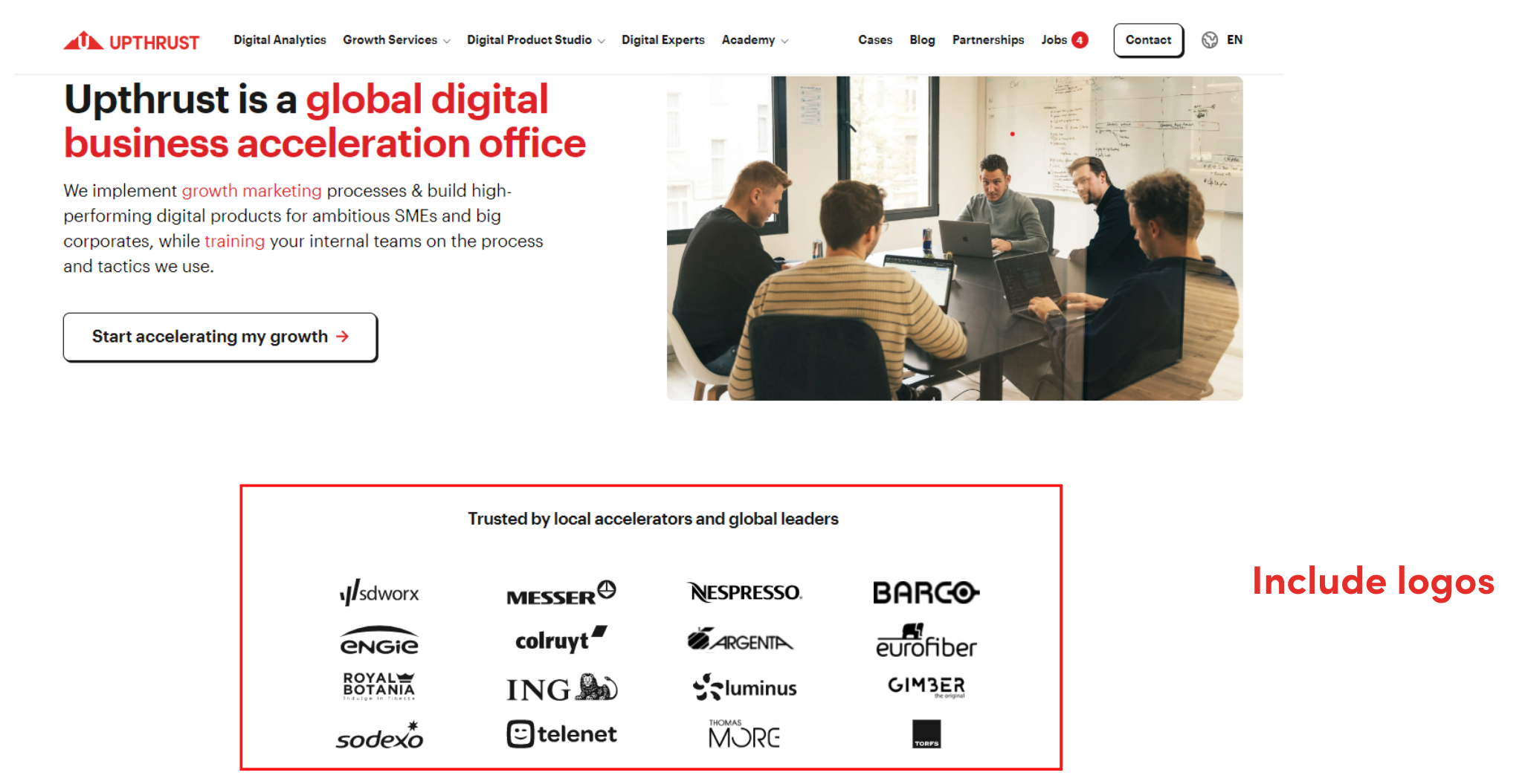Brand storytelling: How to sell more with the proven 7-step framework.

How to use storytelling to sell your products – 7-step framework
You wanted to hear one more story before you sleep. So did everybody else. Stories are imprinted to our minds when we’re kids and you’re a master story listener. Me too.
You can understand when you hear a good story. And you then decide to keep listening, reading or watching. The same goes for your website visitors, they can tell if a brand has a good story. And if not, they’ll not buy from you.
Why?
Because people don’t buy from brands that they couldn’t relate to. And to build this relationship, you should have a story. A brand story that resonates with your visitors.
Of course, brand storytelling has nothing to do with fairytales. But once you apply the fairytale structure to your brand story, people will stay to hear it.
By the end of this article, you’ll be able to tell a story that clicks with your visitors with 7-Step Storyhouse Framework.
Once you learn the framework, you’ll start to create a consistent marketing strategy and collateral. Moreover, you can apply it to any content marketing or marketing collateral you have. You can create
- Blog content
- LinkedIn posts
- Landing pages
- Emails
- Presentations
- Sales pitches
- And any social media content.
So let’s start with the 5 rules of the game.
5 rules of the storytelling game.
Before our brand storytelling framework, we want to introduce you to the mindset of storytelling. These 5 rules will help you to communicate a clear message by showing you do’s and don’ts of good storytelling.
#1 Lose the fancy hat
Most people are so into what they’re doing that they just can not distance themselves from it.
And when you’re obsessed with your product or service, it’s hard to take a step back and be objective. Because you’re way too deep in the rabbit hole.
You know everything about it. You’re more knowledgeable compared to 99% of the population. Since you’ll sell your product to the same population and that could create some problems.
What kind of problems?
- While you’re writing text material for your brand, you can assume everyone is as knowledgeable as you are. And this could lead to a knowledge gap.
- Your business jargon could rebound to your website copy and content.
- In short, your bright mind could block your visitors from understanding your brand.
That’s why we made The Ruler of Knowledge. To help you out!

We’ve divided the scale above from 0-10 into 3 parts:
- Buying decision
- Knowledge gap
- Where most people operate
Go and browse some random websites, you will notice that they operate between 6-10 by using complex and confusing language, which can go down to 4-5 if they’re asked to tune that down a little bit.
This is still not enough because customers make their buying decisions between 1-3, so they need to break that down more until they’re on the same level. It has to be child & teenage proof while also making it understandable for everyone at the same time.
Make sure to use simple words that even a 10-year-old kid could understand. That’s the line.
#2 It’s never about you.
Make it about them. They’re the hero of their story and you’re the guide that could help them beat their challenges.
Don’t steal the spotlight. Talk about them, use the word “YOU”.
There can not be 2 visitors in this house. It’s important to remember that they walk out that door as soon as you take over their position.
#3 Remain clear
Do not be vague. Always say what you mean directly and don’t tiptoe around your message. Say what you want and what they need to know but then don’t say anything else.
#4 Be willing to leave out stuff
Your product or service could have many different features. But you need to choose one or a maximum of two features to create your message. You can check our value proposition article to understand this rule better.
Too many things at once can lead to confusion. Less is better. Always rethink and rewrite your material.
#5 Put in the work
Writing and execution is everything. You can’t find ideas just by thinking, put them on paper. You’ll see, you’ll find many other ideas on the way to tell your story. This practice will also help you to understand your story better and it’ll help you to explain your story better.
Now to the main event, be my guest in The Storyhouse.
The Storyhouse – 7 Step Framework of Storytelling.
The Storyhouse is the journey of transformation. Every brick has a purpose and designed to help the visitors, in this case, your potential customers.

Let’s discover these bricks together.
#1 Visitor
What do your visitors need? What are they lacking? Why did they decide to visit you in the first place?
These are the questions we should answer in the first step. Here is our take on these questions, in most cases, people are driven by two things.

They’re either looking to survive and thrive or identity transformation.
We assume you already know the benefits of your product, if it fits one of the blocks in the image, your work is rather easy.
All you have to do is to put yourself in your visitor’s shoes. What do they desire? What is the first thing that makes them uncomfortable when they wake up? Ask these kinds of questions and internalize the problems of your visitors.
Here are some good examples.
Examples
- Slack

They are very clear on their page and on their header. What do they offer? They ‘bring the team together, wherever you are’ -> they offer to better the lives of the user’s. The customers want to stay productive and have all their communications in one place, and that’s exactly what slack offers.
- Freeletics

- DEO

This example is from a medical company and it’s very clear here how they can better users’ lives. Right off the bat, it indicates that they improve operating room efficiency. It talked about reducing the pressure on the surgical team, reducing cost (remember we talked about saving money), and increasing patient volume. Lastly, it also taps into the triggers about thriving and surviving that we talked about earlier.
#2 Challenge –
Typically it will be the customer arriving at the house with a challenge they are looking to solve.
As the visitors walk through the house with a challenge, something stops them from getting to the end of the house. There could be several things that are getting in their way.

Now, let’s define these three imaginary customers, Jack. He’s a manager in a marketing company and for the last 2 months, he wasn’t able to hit the monthly revenue target.
External: The physical manifestation of the challenge. The visible part of the problem. Jack is struggling to hit his targets and he needs to resolve this.
Your product could help him to increase his revenue by 10% from the first month.
Internal: The emotional, inner manifestation of the challenge. The invisible part. Jack is ashamed of his team, boss, wife and friends. He lost his confidence and worried about his future.
People buy with emotions, so if you can solve the internal problems, they’ll be more likely to buy from you.
Your product could help him to prove his boss that he’s a good manager and help him to be a confident marketer.
Philosophical: The highest manifestation of the challenge. The purpose and world-view of Jack. He wants to be part of something bigger than him. Maybe he wants to feel a sense of belonging to a group of people like him.
Your product could bring like-minded people together with its community. Or maybe your service could donate 5% of the revenue to clean the oceans.
All three together (External + Internal + Philosophical) create a villain. The villain is made up of these three things attacking the house, but we need to give the visitor something to fight with. The solution.
Here are some good storytelling examples:
Examples
- Sneakers

Here it says ‘You’ll never be late again!’ it suggests that you’re tired of being late again. It’s about feeling like you’re always late. It talks about being fed up. It’s asking questions to agitate the pain point of the customer.
#3 Representative
The representative is you. Your solutions and knowledge about the topic will help them beat the villain. As the guide, you need to show that you’re the go-to solution.
And you can let them know this in several ways.

If there are any other things you want to do, go for it, but be careful not to overdo it. You’re the role that should help the visitor through the house. Keep in mind, they’re the hero. Don’t try to be a hero.
Express empathy: Tell them you were in the same place as them for a while ago. Convince them that you know their challenges, how it feels and you know the way out. They should listen to you because you’ve survived and thrived.
Demonstrate authority: Also, you should prove that you’re credible. If you solved similar challenges before, then show your visitors how you solved it. These could be testimonials, other brands you’re working for (logos), or awards, and so on.
Examples
- Zapier

Normally, including 2-3 testimonials is a good starting point. Be careful about how you display your testimonials, though. Many people tend to show it as a carousel, which is great and we see them everywhere with ads. But the problem is that if we see a carousel of testimonials, our brains automatically think they are ads because our brains are wired like that. So have about 2-3 testimonials, and have them all on the same page.
- Upthrust

Another one is to include logos, as Upthrust did, just below the header. You can display them everywhere you want on the website. It’s all about balancing the positive and negative, and it’s just like a rollercoaster where you trigger different emotions.
#4 The map
A map is presented to the visitor to show them the steps that they should take to succeed and go to the right side of the house.
You would want to share a clear path for your team where the company is going, and where you are going within the company. So this map could be both for your internal marketing team or your potential customers.

Examples
- DEO

In this example, we show how the business works step-by-step.
Step 1: Data gathering
Step 2: Roadmap implementation
Step 3: Measuring roadmap impact.
So this is how the business works.
- Zapier

Zapier does it a little bit differently, but it’s still a perfect one. Integrating, Automating, Innovating so they kind of build on top and how you can connect all their different apps.
In short, your visitor needs to see how easy it is to use your product. What happens after you decide to use the product? Show them step-by-step and help them to buy/use your product.
P.S. Don’t create more than 5 steps. Showing too many steps can lead to confusion.
#5 Call to action
Until now, you have told your visitors about them, their challenges, you and your product. Now it’s time to tell them how they can take action.
People don’t take action unless you tell them.

Repeat your call to actions over and over and find something that you can give away for free, doesn’t matter what it is. This free thing is a lead magnet, basically, a carrot. It could be a free trial, whitepaper, eBook or free consultancy. You got the idea.
Additionally, be very clear in your call to action, as we talked about before. Do NOT be vague. Give people something they can accept or reject.
Examples
- Slack

They have a direct call to action in the front and center where they have the ‘Try slack for free’
- Freeletics

They have one as well. In fact, they have 2. right in the front and center and also the top of the page. It says ‘Start Now’.
#6 Winning door
This door tells your visitor what they’ll look like after they buy your services. Think as if it’s like one of these before and after pictures.
Here you should make them feel how transformative this process is for them. You can see the boxes below. These are the main pillars of transformation, I’m sure your benefit fits one of them.

Here is a tip: If it reduces workload, don’t talk about the workplace benefits only. Remember internal challenges? Spending more time with your kids is also a result of having less workload. And without a doubt, it is more transformational.
From Stay at work mom to stay with kids mom.
In addition to that box above, you can also use these bullets as a starting point:
- Increased revenue
- Better employee satisfaction
- Job satisfaction
- Reduced costs.
So, what does success look like? You can repeat this transformative results all over your website. Since people tend to scan and skim through websites, don’t hesitate to repeat it.
We’ll repeat it again. Repeat it.
Examples
- Sneaker company

They talk about how ‘You’ll always regret the things you didn’t do’. Regret is a powerful feeling. They also talk about getting ripped off by private resellers, being the last in line and feeling like you’re never good enough and fast enough to cut a good deal. This is also touching a bit on the internal challenge with this feeling of inadequacy.
7# Losing door
What if the customers don’t engage? What’s at stake? People are more likely to be motivated to avoid losing €100 than gaining €100. So sprinkle a little bit of ‘failure’ language around like seasoning and it’s important to know that you don’t have to use all the bricks that were shown.
Examples of how to use failure language are getting ripped off, losing to competition, financial instability, and being forever stressed.
Examples
- Slack

Here, they talk about being:
- being more organized
- Being looped in, not out
- Give focus a chance
It’s some of the things that we will gain after using Slack.
2. Deo

They really spelled out what they can gain. It’s about increasing revenue, optimizing total cost per treatment, improving job satisfaction, etc.. so all things people can relate to. They are very specific and very clear in listing the wins.
So, all in all, you should get the same feeling as a customer running through your website. You should be getting a sense of satisfaction or a pleasant feeling of understanding and solution.
Now, this was the last room of The Storyhouse, we hope you find this brand storytelling journey transformative! And ready to transform your visitors into customers.
But wait, you might be asking yourself, “What is the content part at the bottom of the house?” We’ll wrap up by answering that.
Content products, the backbone brick of the house.
As you write and structure the 7-step framework, you’ll rediscover and redefine your brand. And you’ll see this is a fertile process because all of these bricks can translate into different content products.
Like sales pitches, eBooks, new products, whitepapers and so on. So once you build your Storyhouse, you’ll find new things to decorate it.
End of the story.
Thanks for reading. If you have any questions related to brand storytelling, feel free to contact us with an email. We typically answer very quickly (30 minutes or so). Or you can leave your question to our very smart chatbot in the left corner. (Test it, it’s impressive)
And please forward this to your forward if you like it, it helps a lot.
See you around.
